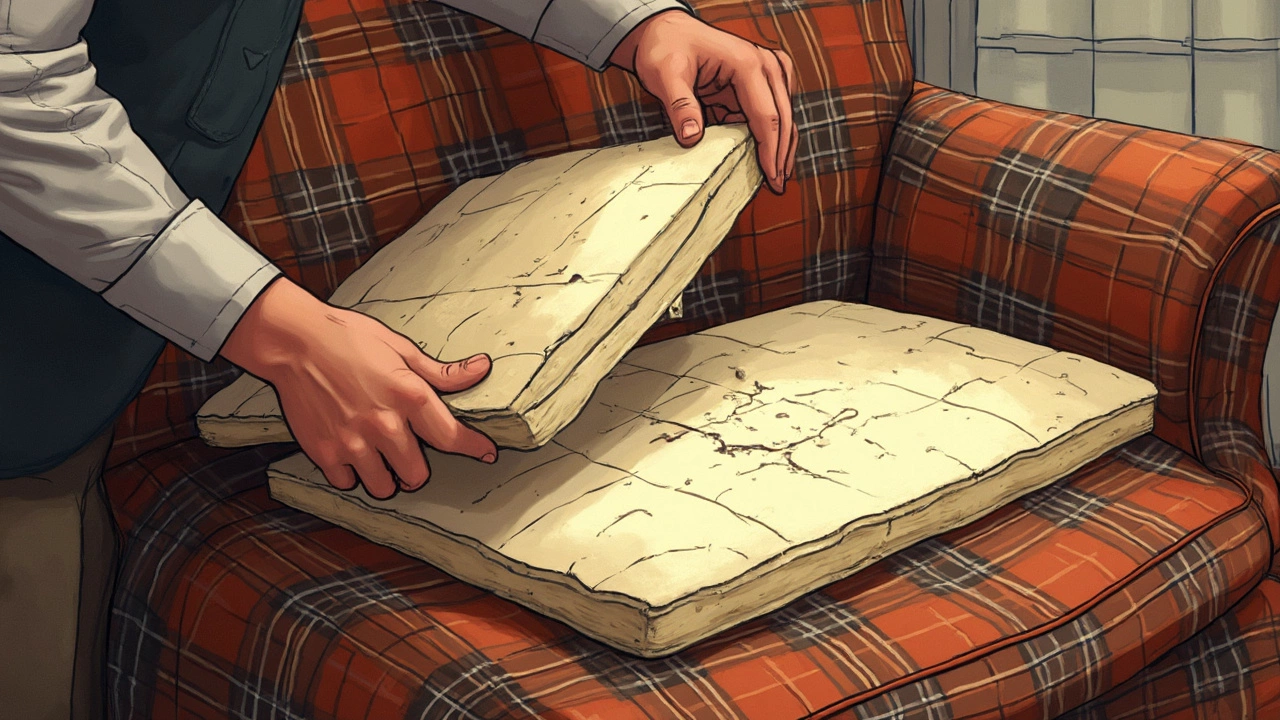Ever sat down on a brand new sofa and thought, "Wow, this is comfy," only to find yourself sinking lower and lower after a few months? That’s the sneaky problem with foam cushions. They look plump and supportive at first, but the story changes faster than you’d expect.
If you lean on your couch a lot—movie marathons, family hangouts, or even naps with your cat (Whiskers loves the sunny spot)—you’ll notice foam can start to flatten out. All those body impressions and saggy spots? That’s not your imagination. Foam just doesn’t bounce back the way you hope, especially once you’ve used it for a while.
And then there’s the sweat factor. Foam doesn’t breathe well, so if you chill in shorts or like to lay down for a bit, things can get sweaty and uncomfortable. Not great, especially in summer when everything feels sticky already.
- Why People Pick Foam Cushions
- Comfort Doesn’t Always Last
- How Foam Cushions Wear Out
- Dealing with Common Foam Problems
- Exploring Better Alternatives
Why People Pick Foam Cushions
Ever walk into a furniture store and see row after row of sofas with perfect, square-looking cushions? Nine times out of ten, those are filled with foam. The reason’s simple: foam is cheap, light, and feels supportive at first sit. That’s a big selling point for a lot of buyers and definitely makes life easier for manufacturers shipping thousands of sofas every year.
Foam cushions also hold their shape really well when they’re brand new. If you want your couch to look showroom-fresh, foam is the easiest win. Plus, you don’t have to shake, fluff, or baby them every day the way you do with down or fiber fills. It’s a very low-maintenance option, at least in the beginning.
You can also get different firmness levels with foam, meaning there’s usually something to suit everyone—whether you like your sofa squishy or prefer a firmer sit. Shops love to upsell customers on “high-density” or “memory foam” upgrades, promising all sorts of comfort and durability claims.
- Foam cushions make mass production easier and cheaper for sofa makers.
- The supportive feel and shape are big selling points for buyers.
- They don’t need daily fluffing or reshaping.
- Available in various firmness levels and can be cut to fit almost any design.
Here's a quick snapshot of why foam's a go-to:
| Reason | How it Helps |
|---|---|
| Cost | Keeps sofas affordable |
| Weight | Makes furniture easier to move |
| Shape | Cushions stay looking new longer (at first) |
| Choice | Firm to soft options for any preference |
If you’re on a budget or just want a “good enough” couch for a spare room, foam definitely pulls its weight. But as you’ll see, that first fresh feeling comes with trade-offs down the road.
Comfort Doesn’t Always Last
When you first sit down on a foam cushion, it feels great. It’s soft and supportive—the perfect combo for kicking back. But here’s the thing: foam doesn’t hold up over time like you’d hope. Most people notice a big drop in comfort after just a year or two, and it’s not just in your head.
Cushion sag is actually super common with foam. After about 12 to 18 months of average use, most standard foam cushions lose about 15% of their original thickness. If you’ve got kids who love jumping on the couch or pets who camp out all day like Whiskers, it might be even faster. The reason is simple: foam cells break down each time you squish them, and once they collapse, the cushion loses its shape and spring.
It’s not just flatness you’ll notice. Cheap foam tends to form “divots” where you usually sit, which means you’re sinking deep in your favorite spot and getting little support for your back or legs. That leads to a lumpy, uneven sofa, and suddenly, lounging is a lot less relaxing.
Plus, foam cushions hold onto heat. Ever stand up and realize the spot where you were sitting is way warmer? That’s because foam traps heat and doesn’t let air move through easily. People who live in warmer places or get hot easily may find it pretty annoying.
| Foam Cushion Lifespan | Comfort Issues Reported |
|---|---|
| 1 year | Minor sag, some heat retention |
| 2 years | Body impressions, loss of support |
| 3+ years | Noticeable dip, uneven feel, hot spots |
So if lasting support is at the top of your list, foam might not be your best bet. It feels nice in the store, but real comfort—the kind that sticks around—is harder to find with most foam cushions.

How Foam Cushions Wear Out
Foam cushions might look solid and reliable when you first bring them home, but the way they wear out can be a real letdown. At first, the foam is dense and supportive, but pretty soon you start to spot some changes you can't ignore.
The most common problem? Foam loses its shape. Every time you sit down, the tiny air pockets in the foam get squished. With all that pressure, the foam just can’t bounce back the same way. Studies show the average foam cushions will start to sag in the spots you use the most within 12 to 24 months. That’s not just a nagging myth—here’s a quick look at how foam cushioning usually goes downhill:
- Flattening: After a year or two, cushions feel harder and look less plump, especially in your favorite spot.
- Body Imprints: You’ll see your own "sit marks" that don’t smooth out, making sofas look old fast.
- Tearing or Crumbling: Lower-quality foam even starts to break apart inside the cover, so you might find weird crumbs or lumps if you open it up.
- Loss of Support: Bad support makes everything uncomfortable—for your back, your snacks, even your pets.
Want a real-world sense of how long foam lasts? Check out this basic breakdown:
| Foam Quality | Estimated Lifespan |
|---|---|
| High-density (2.5 lbs/ft³ or more) | 5-7 years |
| Medium-density (1.8-2.4 lbs/ft³) | 3-5 years |
| Low-density (under 1.8 lbs/ft³) | 1-3 years |
If your sofa is getting daily use—let’s say you crash out on it every night—those numbers might shrink even further. Even the best foam eventually loses its edge, especially if your home is the go-to place for movie nights or pets who like to sprawl just as much as you do. Once the cushion wears out, it’s not easy to fix—you either replace the foam, pay for re-stuffing, or start shopping for a new sofa altogether. Not exactly ideal.
Dealing with Common Foam Problems
Almost everyone with foam cushions runs into the same set of problems after a while—flattening, sagging, and weird smells. Good news is, there are ways to manage them, at least for a bit. Here’s what people usually run into and how you can handle it.
The biggest gripe with foam cushions is their habit of losing shape way too soon. The more you sit in the same spot, the deeper the dent. Research from furniture testing groups shows average low- to mid-density foam starts flattening noticeably in under 18 months, especially if the sofa sees heavy use.
| Problem | Typical Onset | Quick Fix |
|---|---|---|
| Sagging/flattening | 12-18 months | Rotate and flip cushions weekly |
| Odor | First few weeks, can return with humidity | Air out cushions, sprinkle baking soda |
| Lumps or uneven spots | 2+ years | Manually fluff, use cushion pads |
So what actually helps? Start with the basics: flip and rotate your cushions often. Every week is best—even just moving them around makes them wear down less in the same spot. If you’re like me and the cat has a favorite corner, try to even it out.
Dealing with odors is next on the list. New foam has that faint chemical smell (that “off-gassing”), which usually fades in a couple weeks. If it sticks around or comes back when it’s humid, take your cushions outside! A few hours in fresh air or a sprinkle of baking soda (leave it overnight and vacuum up) makes a serious difference.
When lumps or flattened patches pop up, don’t just accept it. Remove the covers, give the foam a good fluff, and slap in a thin cushion pad if needed. It won’t fix old, worn-out foam, but it’ll buy you more time until you’re ready for a replacement.
Keep in mind, though, these fixes won’t make foam cushions last forever. If the material has broken down (it feels crumbly or never bounces back), it’s replacement time. Spending a bit more upfront on higher density foam can help avoid a lot of these routine headaches in the first place.

Exploring Better Alternatives
If you’re tired of flipping or fluffing your foam cushions, you’re not stuck with them. You’ve actually got some solid options that can outlast and out-comfort basic foam, especially if comfy foam cushions aren’t living up to their hype in your living room.
The first upgrade people usually talk about is down or feather fill. These cushions feel super plush the second you sit down. A well-known upholstery source, The Spruce, says,
“Down-filled cushions have unbeatable softness and luxury, but require regular fluffing to keep their shape.”
Down does have that cloud-like feel, but it’s not perfect for everyone, especially allergy sufferers or anyone who hates daily sofa maintenance. Plus, it’s not budget-friendly.
If you want something supportive and low-maintenance, look at innerspring cushions or high-resilience foam mixed with a softer top layer. Innerspring cushions actually have small coils inside, like mattresses, so posture support sticks around no matter how many binge sessions you log. High-resilience foam cushions, on the other hand, hold their shape much longer than standard foam.
- Innerspring Cushions: Last 7-10 years (sometimes even longer if you’re gentle)
- High-Resilience Foam: Usually lasts 8-12 years with normal use
- Down/Feather Fill: Can last 10+ years if maintained, but expect extra work
If you’re looking at what’s inside, here’s a quick at-a-glance stat table to compare cushion types:
| Type | Average Lifespan | Maintenance | Best For |
|---|---|---|---|
| Polyurethane Foam | 2-5 years | Low | Budget shoppers & light use |
| High-Resilience Foam | 8-12 years | Low | Families, daily users |
| Down/Feather | 10+ years | High (needs fluffing) | Luxury feel, adults |
| Innerspring | 7-10 years | Low | Firm support, longer sitting |
Think about who uses the sofa most. Got pets like Whiskers or little kids who turn the couch into a trampoline? Maybe stick with durable, low-fuss innerspring or high-resilience foam. If you want that cozy, special-occasion vibe and don’t mind fluffing, try feather or down. So, next time you test a new couch, unzip those cushions and sneak a peek inside. What’s on the inside totally changes how your sofa will look and feel five years down the line.
